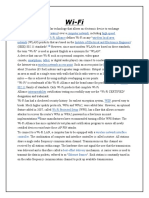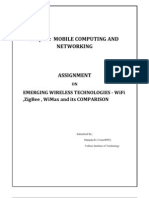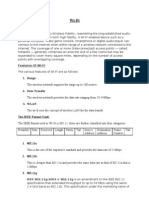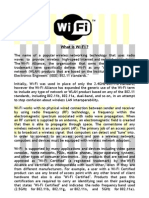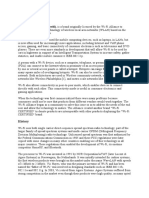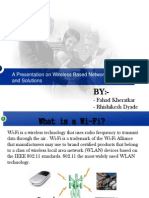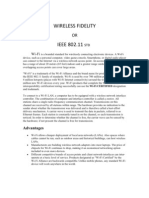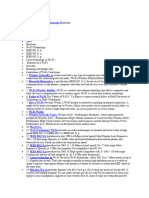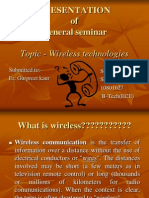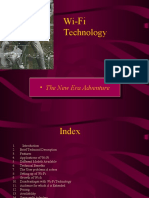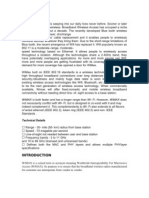The Name Wi-Fi
The Name Wi-Fi
Uploaded by
neemaniguptaCopyright:
Available Formats
The Name Wi-Fi
The Name Wi-Fi
Uploaded by
neemaniguptaOriginal Title
Copyright
Available Formats
Share this document
Did you find this document useful?
Is this content inappropriate?
Copyright:
Available Formats
The Name Wi-Fi
The Name Wi-Fi
Uploaded by
neemaniguptaCopyright:
Available Formats
Wi-fi
Wi-fi is a popular technology that allows an electronic device to exchange data wirelessly over a computer network, including high-speed Internet connections. The Wi-Fi Alliance defines Wi-Fi as any "wireless local area network(WLAN) products that are based on the Institute of Electrical and Electronics Engineers' (IEEE) 802.11 standards". However, since most modern WLANs are based on these standards, the term "Wi-Fi" is used in general English as a synonym for "WLAN". A device that can use Wi-Fi can connect to a network resource such as the Internet via a wireless network access point. Such an access point (or hotspot) has a range of about 20 meters (65 feet) indoors and a greater range outdoors. Hotspot coverage can comprise an area as small as a single room with walls that block radio waves or as large as many square miles this is achieved by using multiple overlapping access points. The name Wi-Fi The term Wi-Fi, first used commercially in August 1999, was coined by a brand-consulting firm called Interbrand Corporation that the Alliance had hired to determine a name that was "a little catchier than 'IEEE 802.11b Direct Sequence'". Belanger also stated that Interbrand invented Wi-Fi as a play on words with Hi-Fi, and also created the Wi-Fi logo. The Wi-Fi Alliance initially used an advertising slogan for Wi-Fi, "The Standard for Wireless Fidelity", but later removed the phrase from their marketing. Despite this, some documents from the Alliance dated 2003 and 2004 still contain the term Wireless Fidelity. There was no official statement related to the dropping of the term. The yin-yang Wi-Fi logo indicates the certification of a product for interoperability. Non-Wi-Fi technologies intended for fixed points such as Motorola Canopy are usually described as fixed wireless. Alternative wireless technologies include mobile phone standards such as 2G,3G or 4G.
To connect to a Wi-Fi LAN, a computer has to be equipped with a wireless network interface controller. The combination of computer and interface controller is called a station. All stations share a single radio frequency communication channel. Transmissions on this channel are received by all stations within range. The hardware does not signal the user that the transmission was delivered and is therefore called a best-effort delivery mechanism. A carrier wave is used to transmit the data in packets, referred to as "Ethernet frames". Each station is constantly tuned in on the radio frequency communication channel to pick up available transmissions.
The wi-fi signal loop
Internet access A Wi-Fi-enabled device can connect to the Internet when within range of a wireless network connected to the Internet. The coverage of one or more (interconnected) access points called hotspots can extend from an area as small as a few rooms to as large as many square miles. Coverage in the larger area may require a group of access points with overlapping coverage. Outdoor public Wi-Fi technology has been used successfully in wireless mesh networks in London, UK. Wi-Fi provides service in private homes, high street chains and independent businesses, as well as in public spaces at Wi-Fi hotspots set up either free-of-charge or commercially. Organizations and businesses, such as airports, hotels, and restaurants, often provide free-use hotspots to attract customers. Enthusiasts or authorities who wish to provide services or even to promote business in selected areas sometimes provide free Wi-Fi access. Routers that incorporate a digital subscriber line modem or a cable modem and a Wi-Fi access point, often set up in homes and other buildings, provide Internet access and internetworking to all devices connected to them, wirelessly or via cable. With the emergence of MiFi and WiBro (a portable Wi-Fi router) people can easily create their own Wi-Fi hotspots that connect to Internet viacellular networks. Now Android, Bada, iOS (iPhone), and Symbian devices can create wireless connections. Wi-Fi also connects places that normally don't have network access, such as kitchens and garden sheds. Wi-Fi networks have limited range. A typical wireless access point using 802.11b or 802.11g with a stock antenna might have a range of 32 m (120 ft) indoors and 95 m (300 ft) outdoors. IEEE 802.11n, however, can more than double the range. Range also varies with frequency band. Wi-Fi in the 2.4 GHz frequency block has slightly better range than Wi-Fi in the 5 GHz frequency block which is used by 802.11a. On wireless routers with detachable antennas, it is possible to improve range by fitting upgraded antennas which have higher gain in particular directions. Outdoor ranges can be improved to many kilometers through the use of high gain directional antennas at the router and remote device(s). In general, the maximum amount of power that a Wi-Fi device can transmit is limited by local regulations, such as FCC Part 15 in the US.
Due to reach requirements for wireless LAN applications, Wi-Fi has fairly high power consumption compared to some other standards. Technologies such as Bluetooth (designed to support wireless PAN applications) provide a much shorter propagation range of <10m and so in general have a lower power consumption. Other low-power technologies such as ZigBee have fairly long range, but much lower data rate. The high power consumption of Wi-Fi makes battery life in mobile devices a concern. Researchers have developed a number of "no new wires" technologies to provide alternatives to Wi-Fi for applications in which Wi-Fi's indoor range is not adequate and where installing new wires (such as CAT-5) is not possible or cost-effective. For example, the ITUT G.hn standard for high speed Local area networks uses existing home wiring (coaxial cables, phone lines and power lines). Although G.hn does not provide some of the advantages of Wi-Fi (such as mobility or outdoor use), it's designed for applications (such as IPTV distribution) where indoor range is more important than mobility. Due to the complex nature of radio propagation at typical Wi-Fi frequencies, particularly the effects of signal reflection off trees and buildings, algorithms can only approximately predict Wi-Fi signal strength for any given area in relation to a transmitter. This effect does not apply equally to long-range Wi-Fi, since longer links typically operate from towers that transmit above the surrounding foliage. The practical range of Wi-Fi essentially confines mobile use to such applications as inventory-taking machines in warehouses or in retail spaces, barcode-reading devices at check-out stands, or receiving/shipping stations. Mobile use of Wi-Fi over wider ranges is limited, for instance, to uses such as in an automobile moving from one hotspot to another. Other wireless technologies are more suitable for communicating with moving vehicles
To setup a wireless networkIts handy, simple and relatively cheap to set up a wireless (WiFi) network in your own home. It saves you from having to connect and disconnect all sorts of wires for your computers just in order to hook up to the Internet. If you want to create your own wireless network at home, youll need a wireless access point. If your home computers arent networked, or if you want to replace your Ethernet network youll need to set up a wireless router. This will enable you to use either wireless radio signals or Ethernet cables to link up your computers to each other, to your printer, and also to the Internet. The 802.11g router is usually recommended as it is fast and reliable. Once the router is plugged in, it will work according to its default settings. You can alter the settings by accessing a Web interface. Select the name of the network, which is also known as its service set identifier (SSID). Choose a channel. Most people -- probably including your neighbors -- use channel six, which might cause interference on your line, so choose a different channel. Set up a username and password to protect the security of your router;
otherwise, anyone nearby with a wireless card in their computer will be able to tap into your signal. To protect the privacy of your network, you could use the WiFi Protected Access (WPA), which is a new-and-improved version of the once standard Wired Equivalency Privacy (WEP) security program. This is the option most public hotspots use, and it can be accessed by signing in with a password. Alternatively, you could set up a Media Access Control (MAC) address-filtering program, which does not rely on passwords. To do this, youll have to set up your router with a list of the specific MAC addresses on your computers.
AdvantagesOne of the most prevalent advantages of WiFi wireless LAN technologies is that it is completely wire-free. Now, if you want to sit in one of your comfort zones in you house, such as a couch or in your yard, you can carry your laptop with you and still be able to access the internet.
There are many WiFi advantages to users. Let's have a closer look at them:
WiFi uses unlicensed radio spectrum and does not require regulatory approval forindividual deployers.
It allows local area networks (LANs) to be setup with cabling. The can reduce associated costs of network connection and expansions. Places where cables cannot be run, such as outdoor areas and historical buildings can use wireless LANs. WiFi products are extensively available in the market. There are different brands of access points and user's network interfaces are able to inter-operate at a very basic service level. Prices are considerably lower as competition amongst vendors' increases. WiFi networks can support roaming. This allows mobile users with laptop computer to be able to move from one access point to another.
Numerous access points and network interfaces support various degrees of encryption to protect traffic from interception.
WiFi has a set of global standards. Not like the cellular carriers, the same WiFi users can work in different countries around the world at all time.
DisadvantagesDue the fact that WiFi are still relatively new, there are considerably more disadvantages to users. Let's have a look at them:
The use of WiFi band that is 2.4 GHz does not require a license in most countries provided that is stays below limit of 100mW and one accepts interference from other sources; including interference which causes the users devices to no longer function.
The spectrum assignments and operational limitations are not consistent worldwide. Power consumption is fairly high compared to some other standards, making the battery life and heat a concern to some users.
WiFi uses the unlicensed 2.4GHz spectrum, which often crowded with other devices such as Bluetooth, microwave ovens, cordless phones, or video sender devices, and among many others. This may cause degradation in performance. WiFi networks have limited range. A typical WiFi home router might have a range of 45m (150ft) indoors and 90m (300ft) outdoors. Ranges may also vary as WiFi is no exception to the physics of radio wave propagation with frequency band. The most common wireless encryption standard, wired equivalent privacy or WEP has been shown to be breakable even when it has been correctly configured. Access points could be used to steal personal and confidential information transmitted from WiFi consumers. Intervention of a closed or encrypted access point with other open access points on the same or a nearby channel can prevent access to the open access points by others in the area. It poses a high problem in high-density areas such as large apartment blocks where many residents are operating WiFi access points.
Inter-operability issues between brands or deviations can cause limited connection or lower output speeds. Free access points can be used by the malicious to anonymous to initiate an attack that would be extremely difficult to track beyond the owner of the access point.
You might also like
- Wi-Fi: Wi-Fi Is A Popular Technology That Allows An Electronic Device To ExchangeDocument3 pagesWi-Fi: Wi-Fi Is A Popular Technology That Allows An Electronic Device To ExchangeVikasVickyNo ratings yet
- Wi-Fi Is A Popular Technology That Allows An ElectronicDocument13 pagesWi-Fi Is A Popular Technology That Allows An Electronicc1a2m3p4y5100% (1)
- Comparison Wifi, Wimax and ZigbeeDocument11 pagesComparison Wifi, Wimax and ZigbeeManjula Rajgopal100% (6)
- Wi-Fi Is: Trademark Wi-Fi Alliance Wireless Local Area Network IEEE 802.11 PAN LAN WAN IEEE 802.11Document18 pagesWi-Fi Is: Trademark Wi-Fi Alliance Wireless Local Area Network IEEE 802.11 PAN LAN WAN IEEE 802.11devg_777No ratings yet
- Wi FiDocument6 pagesWi FiAtul PalNo ratings yet
- What Is WifiDocument7 pagesWhat Is WifiHemant ThakkarNo ratings yet
- Router: Device Networks Wans ISP's GatewaysDocument14 pagesRouter: Device Networks Wans ISP's GatewaysMay Responte GayNo ratings yet
- Wi-Fi Technolgy: Webopedia)Document6 pagesWi-Fi Technolgy: Webopedia)Dasari Jaswanth NaiduNo ratings yet
- EC-0113 Wireless Technologies, Wire Less Fidelity (Wi-Fi) & World Wide Interoperability For Microwave Access (Wimax) Mr. P.Goutham .Mr. VishalDocument9 pagesEC-0113 Wireless Technologies, Wire Less Fidelity (Wi-Fi) & World Wide Interoperability For Microwave Access (Wimax) Mr. P.Goutham .Mr. VishalBhavani ThirumalasettyNo ratings yet
- Shawon WifiDocument10 pagesShawon WifiFoez LeonNo ratings yet
- WI-FI ReportDocument5 pagesWI-FI ReportAbdelrhmanwalid WaleeedNo ratings yet
- WifiDocument5 pagesWifisb_rameshbabu3283No ratings yet
- Wi FiDocument14 pagesWi FiSachin Kumar BassiNo ratings yet
- Wifi SeminarDocument10 pagesWifi SeminarAmandeep AmanNo ratings yet
- Definition of Wi-Fi:: Wireless Fidelity Is Its Unofficial. It Is A Wireless Technology Brand Owned byDocument9 pagesDefinition of Wi-Fi:: Wireless Fidelity Is Its Unofficial. It Is A Wireless Technology Brand Owned bySaikat HalderNo ratings yet
- Wi FiDocument3 pagesWi FiLaxmi Narayan ReddyNo ratings yet
- Wifi. What Is It?: NCR Corporation At&T Lucent Agere Systems NieuwegeinDocument17 pagesWifi. What Is It?: NCR Corporation At&T Lucent Agere Systems NieuwegeinYogesh JainNo ratings yet
- Wi-Fi (Pronounced Wye Fye,: Citation NeededDocument82 pagesWi-Fi (Pronounced Wye Fye,: Citation NeededShubha Shankar MohapatraNo ratings yet
- Seminar Report ON: Submitted By: SwapnilDocument34 pagesSeminar Report ON: Submitted By: SwapnilSWAPNIL_1212SONALINo ratings yet
- Airport: What Is Wifi?Document4 pagesAirport: What Is Wifi?lipi_chhayaNo ratings yet
- Hamza Wi-Fi Term PaperDocument11 pagesHamza Wi-Fi Term Paperhamzabilal90No ratings yet
- Final Wibree DocumentDocument28 pagesFinal Wibree DocumentPradeep ReddyNo ratings yet
- Wi-Fi: Wifi (Also Wifi, Wi-Fi or Wifi), Is A Brand Originally Licensed by The Wi-Fi Alliance ToDocument8 pagesWi-Fi: Wifi (Also Wifi, Wi-Fi or Wifi), Is A Brand Originally Licensed by The Wi-Fi Alliance ToSameer NarulaNo ratings yet
- Wi-Fi: The BasicsDocument4 pagesWi-Fi: The BasicsAjay SanchetiNo ratings yet
- Introduction.: Wi-Fi Technology ContentsDocument13 pagesIntroduction.: Wi-Fi Technology ContentsJamesCarterNo ratings yet
- DocumentDocument12 pagesDocumentirfanms1256No ratings yet
- Presentation On Wireless Technologies Submitted By:-Arvind ROLL NO..17 10809501Document18 pagesPresentation On Wireless Technologies Submitted By:-Arvind ROLL NO..17 10809501Chaitali BinzadeNo ratings yet
- Fahad Kheratkar - Rhishikesh Dyade: A Presentation On Wireless Based Network and SolutionsDocument24 pagesFahad Kheratkar - Rhishikesh Dyade: A Presentation On Wireless Based Network and SolutionsFahad Impresionante KheratkarNo ratings yet
- Wi-Fi Technology: B y N.Nirmal Kumar P.SudheerDocument14 pagesWi-Fi Technology: B y N.Nirmal Kumar P.SudheerZeeshan AliNo ratings yet
- UHF and 5 Gigahertz (60 MM) SHF ISM Radio BandsDocument3 pagesUHF and 5 Gigahertz (60 MM) SHF ISM Radio BandsAnandhu cNo ratings yet
- Wifi in Wireless CommunicationDocument7 pagesWifi in Wireless CommunicationDevansh DaveNo ratings yet
- 2914 Wifi Technology2Document23 pages2914 Wifi Technology2jay shree ramNo ratings yet
- 3 Wi-FiDocument10 pages3 Wi-FiAnusha ThammanaNo ratings yet
- Now A Day It Is Very Easy To Establish Communication From One Part of The Worldto Other. Despite ThisDocument6 pagesNow A Day It Is Very Easy To Establish Communication From One Part of The Worldto Other. Despite ThisBhavisha AsharaNo ratings yet
- Wireless FidelityDocument2 pagesWireless Fidelityvintin4uNo ratings yet
- Wireless NetworksDocument17 pagesWireless NetworksMian Muzammil AhmedNo ratings yet
- Wi-Fi Evolution and Its WorkingDocument12 pagesWi-Fi Evolution and Its WorkingVipul SinhaNo ratings yet
- Wifi Notes PDFDocument0 pagesWifi Notes PDFnataline_dedonaNo ratings yet
- Wi-Fi Technology: Mesh NetworkDocument12 pagesWi-Fi Technology: Mesh Networksathiyamca26No ratings yet
- Presentation of General Seminar: Topic - Wireless TechnologiesDocument22 pagesPresentation of General Seminar: Topic - Wireless TechnologiesDeepanshu BansalNo ratings yet
- Bluetooth vs. Wi-Fi: Cats and Dogs Livivng TogetherDocument25 pagesBluetooth vs. Wi-Fi: Cats and Dogs Livivng TogetherKrunal PatelNo ratings yet
- Bluetooth: It Is A Basic Form of Connectivity Wireless Free From Cables Range 30-60 FeetDocument6 pagesBluetooth: It Is A Basic Form of Connectivity Wireless Free From Cables Range 30-60 FeetRahul RockNo ratings yet
- Computer Networking Image Gallery: Inside This ArticleDocument6 pagesComputer Networking Image Gallery: Inside This ArticleYogesh GiriNo ratings yet
- Wi-Technology: - The New Era AdventureDocument32 pagesWi-Technology: - The New Era Adventuresunnybajaj4u8917No ratings yet
- Wi-Technology: - The New Era AdventureDocument32 pagesWi-Technology: - The New Era AdventureZatin Gupta100% (1)
- WifiDocument6 pagesWifiARVINDNo ratings yet
- Wi-Fi Is A Popular Technology That Allows An Electronic Device To ExchangeDocument13 pagesWi-Fi Is A Popular Technology That Allows An Electronic Device To ExchangePrince ABNo ratings yet
- WifiDocument17 pagesWifiRavi JoshiNo ratings yet
- Scope in WiFiDocument5 pagesScope in WiFiSalman Khan0% (1)
- Introduction To How WiFi WorksDocument4 pagesIntroduction To How WiFi WorksDeepak SinhaNo ratings yet
- What Are The Differences and Similarities Between Wi-Fi and Wimax?Document3 pagesWhat Are The Differences and Similarities Between Wi-Fi and Wimax?Salman KhanNo ratings yet
- WifiDocument5 pagesWifiPawan KumarNo ratings yet
- Wifi and BluetoothDocument17 pagesWifi and BluetoothbluechelseanNo ratings yet
- TarunDocument2 pagesTarunInderjit SinghNo ratings yet
- Wimax Versus Wi-Fi: A Seminar ReportDocument34 pagesWimax Versus Wi-Fi: A Seminar ReportTiju George VarugheseNo ratings yet
- Understanding WiFi Technology: A Comprehensive Guide (Second Edition)From EverandUnderstanding WiFi Technology: A Comprehensive Guide (Second Edition)No ratings yet
- WiFi, WiMAX, and LTE Multi-hop Mesh Networks: Basic Communication Protocols and Application AreasFrom EverandWiFi, WiMAX, and LTE Multi-hop Mesh Networks: Basic Communication Protocols and Application AreasNo ratings yet
- Beyond 3G - Bringing Networks, Terminals and the Web Together: LTE, WiMAX, IMS, 4G Devices and the Mobile Web 2.0From EverandBeyond 3G - Bringing Networks, Terminals and the Web Together: LTE, WiMAX, IMS, 4G Devices and the Mobile Web 2.0No ratings yet

